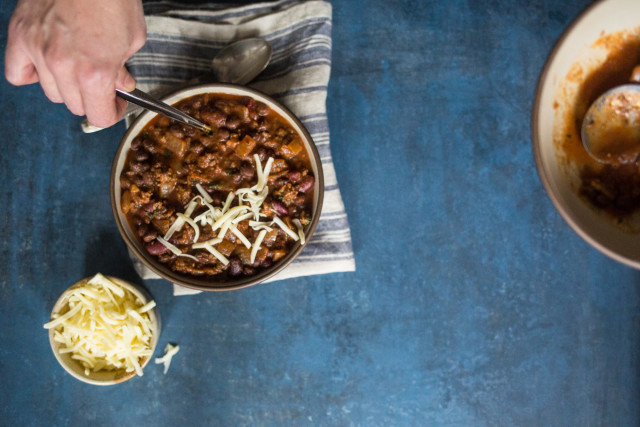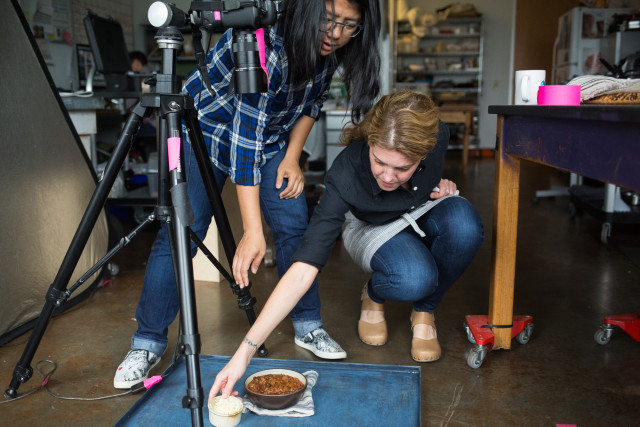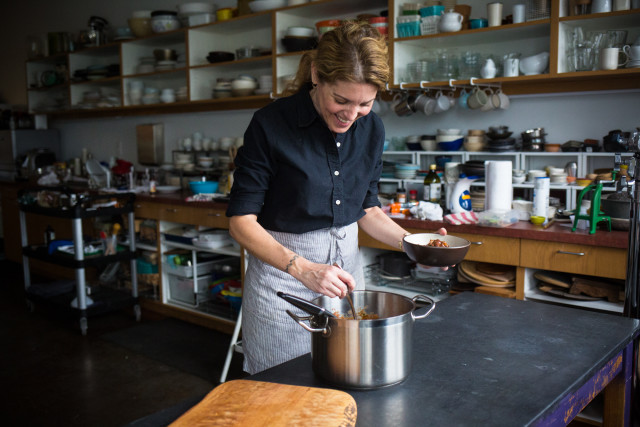Austin Food Stylists Are Skilled at Making Dishes Ready for Their Close-Ups
By Travis Putnam Hill
Reporting Texas

Foods stylist Tina Bell Stamos uses tweezers to perfect the appearance of a chili dish in preparation for a food photo shoot at Whole Foods. Lukas Keapproth/Reporting Texas
For Reporting Texas
Tina Bell Stamos crouches over a bowl of chili on the floor. She uses tweezers to meticulously arrange individual strips of shredded white cheddar on the surface of the lukewarm meat and beans. Then, with a heat gun, a tool typically used to strip paint, she melts the cheese to look as if it had been casually sprinkled on the chili fresh off the stove.
Stamos steps back to allow photographer Ha Lam to capture the scene. It’s one of about six Whole Foods recipes the team will shoot by the end of the day. While Lam shoots the pictures, it’s Stamos’ job as a food stylist to sculpt the food to photogenic perfection.
Food stylists play an important but often unrecognized role in food advertising. Great taste does not translate easily to photographs. Many foods wilt or crumble from the handling and time required to capture just the right shot. Food stylists employ equal parts visual artistry, culinary craft and trickery to make food look good for the camera.
Despite Austin’s reputation as a creative community with a vibrant food scene, it is no food styling hub, though the city is home to a small but productive contingent of food stylists.
Whole Foods is one of the few companies with full-time food stylists on its payroll. Other companies enlist stylists for the occasional project.
Erin Quinn-Kong, editor-in-chief of Austin Monthly, said her magazine brings in stylists when food is on the cover or in the opening spread of a feature. Food stylists help the photographer take the photo to “the tip-top level that we want,” Quinn-Kong said. “They just are able to make a sandwich look absolutely perfect.”

Ha Lam (left), national projects photographer at Whole Foods, and stylist Tina Bell Stamos concentrate on making a bowl of chili look its best during a photo shoot. Lukas Keapproth/Reporting Texas
The job of a food stylist is to help photographers capture the essence of a product, or to showcase “hero food,” the industry term for the perfect specimen of a dish.
“My goal is to make the client happy,” said Stamos, 46, who started food styling about 15 years ago as she transitioned away from the catering business she owned in Lawrence, Kansas. But she also wants “to make beautiful images.”
Like fashion, trends in food styling change. The preference for gaudy, ornate presentations, and rather unappetizing food, in the 1970s, has given way to an emphasis on the artisanal.
“Messy is in,” Stamos said. Much of her portfolio reflects that style. A photo of baguette, for example, shows sliced bread casually laid out alongside scattered crumbs and a jam-smeared spoon atop a rustic table.
Stamos is the in-house stylist for Whole Foods. Her past clients include Texas-based companies such as Frito Lay and H-E-B, as well as national restaurant chains such as Taco Bell and Applebee’s.
Though food stylists’ primary aim is to please their clients, they also take pride in the creative qualities of their work.
“I try to use [food] as a substance, a material, rather than something I can cook and put on a plate,” said Austin-based food stylist Tyna Hoang, 28. “It can be way more than just a meal.”
Some of Hoang’s editorial work leans toward the abstract, more modernist sculpture than something edible. In one piece, a radish sliced in half rests in a tiny red lawn chair facing a mirror that reflects the vegetable’s pink and white innards.
Hoang said she got into food styling “not knowing what it was at all.” Like most stylists, she is largely self-taught. Now in the business for three years, she has done commercial work for the Food Network, Whole Foods and a new local chicken sandwich joint called Flyrite, among others.
Food stylists employ a potpourri of gadgets and tricks to execute their work. Their tools range from those commonly found in the kitchen (knives and spatulas) to the unexpected (Q-tips and heat guns). And even the commonplace items are used in unconventional ways. For instance, if a shoot involves tacos, Stamos might use Corn Huskers Lotion to moisturize the tortillas, making them pliable yet firm enough to avoid cracking.
In styling soup, Stamos likes to add instant mashed potatoes to the bottom of the bowl “to elevate and prop things up so that all of the ingredients can be seen and people know what they’re getting.”
A lot of food in photographs is actually edible, though it might not taste all that good. (Think copious amounts of cooking oil brushed on meat.)
On the same day that Stamos prepped the chili, she also styled a recipe for grilled salmon with a tomato, olive and caper sauce. Rather than actually grilling the slabs of salmon, she threw them in the oven briefly, then seared simulated grill marks onto the fish with the hot coil of an electric charcoal starter.
She also didn’t cook the sauce all the way so that the tomatoes would maintain their vibrant red.
“You want it to be its ultimate color on a quick read,” she said.
Asked about the artifice inherent to her work, Stamos said she isn’t misrepresenting the food and that she uses only the ingredients included in the recipe.
Lam, who is national projects photographer for Whole Foods, said she and Stamos are just putting the food in the “best possible light.”

Food Stylist Tina Bell Stamos scoops chili into a bowl in preparation for a food photoshoot at Whole Foods in Austin, TX., on Tuesday, April 12, 2016. Lukas Keapproth/Reporting Texas
Some shoots, however, require inedible ingredients.
Leading up to one of her first food styling gigs, which was for local beverage company High Brew Coffee, Hoang needed fake ice cubes. She made them herself by melting acrylic beads in foil molds.
“I just stunk up the whole house, and it smelled like plastic,” she said. But when it came time to shoot, she had convincingly real plastic cubes.
Austin does not provide sufficient work for budding food stylists like Hoang. Many gigs are in New York and San Francisco, or even Kansas City and Dallas. Hoang recently started splitting her time between Austin and New York to find more opportunities, even if that means working less as a lead stylist and more as an assistant.
“I wanted to find growth in the industry,” she said. “I feel like Austin will get to a bigger level at some point, but [the supply of local work] wasn’t enough for me to be doing that full time. “
According to Simply Hired, a jobs website, the average salary of a food stylist in Austin is $35,000 per year. In New York, it’s $42,000. Most food stylists work freelance. Their income depends on how much work they can find. Once they become more established, food stylists can earn as much as $450 to $850 a day, according to CulinarySchools.com.
Olivia Caminiti, 27, is trying to mark her mark from Austin. She has had opportunities to assist several accomplished stylists, including Stamos, and for the last year and a half, she has been working as a lead stylist. Just the other day, she prepped some waffles, bacon and eggs for a shoot for Hampton Inn.
“It’s a smaller pond,” Caminiti said of Austin. “But you become a bigger fish.”